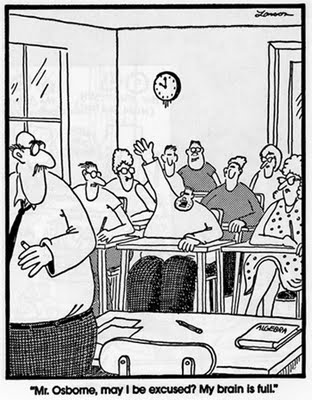Lecture 23 (Nov 29)
Today we proved two important theorems: the 1st isomorphism theorem (discussed last time) and an abelian version of Cauchy's theorem (a special case of which you've seen on the homework).
Click here for Lecture 23 notes
Lecture 22 (Nov 25)
Today we discussed how isomorphisms can be used to connect complicated groups to groups we understand. We stated the 1st Isomorphism Theorem, and saw an application of it.
Click here for Lecture 22 notes
Lecture 21 (Nov 22)
Today we formally defined what it means for two groups to be isomorphic, in particular defining the notion of an isomorphism. We explored a few examples of isomorphic groups, as well as some basic results. We were then led to the notion of homomorphism.
Click here for Lecture 21 notes
Lecture 20 (Nov 18)
Today we began discussing the concept of isomorphism. We played the Game of 15, and also developed multiplication tables of groups using the Sudoku principle. Finally, we played around with group presentation.
Click here for Lecture 20 notes
Lecture 19 (Nov 15)
We continued discussing quotients of groups, eventually arriving at the notion of normal subgroups. We then found a criterion for testing whether a given subgroup is normal. Finally, we observed that every subgroup of an abelian group is normal. This led us to experiment with ℤ/3ℤ.
Click here for Lecture 19 notes
Lecture 18 (Nov 11)
Further discussion of quotients of groups, in particular introducing a group law on a quotient. This lecture was given by Zsuzsanna Dancso. Thanks, Zsuzsi!
Click here for Lecture 18 notes
Lecture 17 (Nov 8)
We discussed factoring a subgroup out of a group.
Click here for Lecture 17 notes
Lecture 16 (Nov 4)
We discussed subgroups generated by elements of a group. This led to an improvement of our theorem classifying the subgroups of ℤ.
Click here for Lecture 16 notes
Lecture 15 (Nov 1)
We continued our discussion of subgroups. Exploring examples led us to classify all the subgroups of ℤ.
Click here for Lecture 15 notes
Lecture 14 (Oct 28)
We proved uniqueness of inverses and began discusing subgroups.
Click here for Lecture 14 notes
Lecture 13 (Oct 25)
We gave some more exotic examples of groups. We also started exploring properties of groups.
Click here for Lecture 13 notes
Lecture 12 (Oct 21)
After a heuristic for what makes a binary operation `nice', we explored a bunch of examples and non-examples of groups.
Click here for Lecture 12 notes
Lecture 11 (Oct 11)
We discussed geometric equivalence. More precisely, we tried to find a natural notion of equivalence on the set of all plane isometries, and were partially successful. This led us the definition of a group, which will be our primary topic for the rest of the term. For more details, click below.
Click here for Lecture 11 notes
Lecture 10 (Oct 7)
We completed the classification of the symmetries of the square, by proving that any symmetry must fix the origin. Click below for details.
Click here for Lecture 10 notes
Lecture 9 (Oct 4)
Today we attempted to classify the symmetries of the square by proving that the eight we found last time are the only possible ones. Click the link below for details.
Click here for Lecture 9 notes
Lecture 8 (Sept 30)
After discussing some comments made by Ivan about the first problem set, we discussed symmetry. In particular, we came up with a definition of a symmetry of an arbitrary set of points, and explored the definition with two examples. Click the link below for details.
Click here for Lecture 8 notes
Lecture 7 (Sept 27)
We finished the proof of the lemma, that every isometry can be expressed uniquely as the composition of a translation, a rotation around the origin, and (possibly) a reflection across the x-axis. We also discussed the classification theorem: that every isometry is a translation, a rotation, or a glide reflection. In particular, we reduced the proof to showing that Th Rα ρ must be a glide reflection. For more details, click the link below.
Click here for Lecture 7 notes
Lecture 6 (Sept 23)
Today we (almost) proved the conjecture from last time: that every isometry is built out of our three primitive isometries. For more details, click below.
Click here for Lecture 6 notes
Lecture 5 (Sept 20)
We explored how to simplify arbitrary compositions of translations, rotations, and reflections. In particular, we gave a simple description of reflections (and glide reflections) in terms of our primitive isometries Th, Rα, and ρ. For more details, click below.
Click here for Lecture 5 notes
Lecture 4 (Sept 16)
We discussed rotations around points other than the origin. Among other things, we discovered that if we compose a translation with a rotation, we can switch the order of the two if we suitably modify the translation. For more details, click below.
Click here for Lecture 4 notes
Lecture 3 (Sept 13)
We continued discussing isometries, in particular coming up with purely algebraic descriptions of translations, rotations around the origin, and reflections across the x-axis. Along the way, we discussed the connection to matrices, as well as to complex numbers.
Click here for Lecture 3 notes
Lecture 2 (Sept 9)
We talked about isometries, in particular stating a bizarre theorem that all isometries must be one of three types: translations, rotations, or glide reflections.
Click here for Lecture 2 notes
Lecture 1 (Sept 6)
We talked about administrivia, what this course is about, and Euclidean geometry, in particular arriving at a precise definition of what it means for two shapes to be congruent. For more detailed notes, click the button below.
